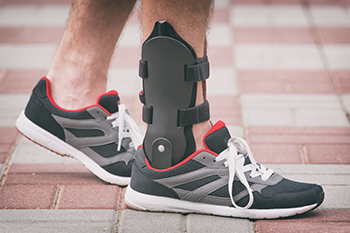Merrillville, IN
Munster, IN
September 2023
Finding the Right Ankle Brace

When it comes to finding the right ankle brace, it's essential to consider your specific needs and condition. Lace-up support braces are tailored for demanding athletes during their sports activities. These braces offer a custom fit, making them easy to put on and remove. For daily use and mild support, ankle braces in the form of sleeves or wrap-arounds may be helpful. These braces offer compression and stability, making them perfect for those with chronic ankle instability or who are recovering from mild sprains. For high-impact sports or activities that involve quick lateral movements and jumping, ankle braces that offer moderate to maximum support are a choice. These braces often feature side stays to prevent ankle rolls. Maximum support braces even come with semi-rigid shells to prevent further injury while allowing normal movement. In cases of severe injuries, fractures, or post-surgery recovery, a boot or full-shell protection brace offers ankle protection and reduces foot pressure while walking. These devices are not suitable for sports and are primarily designed for immediate recovery. To find the proper brace for your ankle recovery, it is suggested that you make an appointment with a podiatrist to determine the best choice for your specific needs.
Ankle pain can be caused by a number of problems and may be potentially serious. If you have ankle pain, consult with Ahmad Elsamad, DPM from The Institute of Foot & Ankle Reconstructive Surgery . Our doctor will assess your condition and provide you with quality foot and ankle treatment.
Ankle pain is any condition that causes pain in the ankle. Due to the fact that the ankle consists of tendons, muscles, bones, and ligaments, ankle pain can come from a number of different conditions.
Causes
The most common causes of ankle pain include:
- Types of arthritis (rheumatoid, osteoarthritis, and gout)
- Ankle sprains
- Broken ankles
- Achilles tendonitis
- Achilles tendon rupture
- Stress fractures
- Bursitis
- Tarsal tunnel syndrome
- Plantar fasciitis
Symptoms
Symptoms of ankle injury vary based upon the condition. Pain may include general pain and discomfort, swelling, aching, redness, bruising, burning or stabbing sensations, and/or loss of sensation.
Diagnosis
Due to the wide variety of potential causes of ankle pain, podiatrists will utilize a number of different methods to properly diagnose ankle pain. This can include asking for personal and family medical histories and of any recent injuries. Further diagnosis may include sensation tests, a physical examination, and potentially x-rays or other imaging tests.
Treatment
Just as the range of causes varies widely, so do treatments. Some more common treatments are rest, ice packs, keeping pressure off the foot, orthotics and braces, medication for inflammation and pain, and surgery.
If you have any questions, please feel free to contact our offices located in Merrillville, and Munster, IN . We offer the newest diagnostic and treatment technologies for all your foot care needs.
Fascinating Facts About Children's Feet

Children's feet are remarkable in their growth and development. Understanding the unique aspects of pediatric foot health can help parents and caregivers provide better care and support for their little ones. Babies are born with a soft and pliable structure in the foot called cartilage, which gradually ossifies into bones, and this process continues into late adolescence. Infants have a naturally wide and flat foot arch that develops into a more pronounced arch as they grow and their muscles strengthen. Additionally, children's feet contain approximately 200,000 sweat glands, which can make them more prone to odor and fungal infections. It is important to note that children often experience rapid growth spurts, and this can require frequent shoe replacements. Wearing ill-fitting shoes can result in foot problems, so regular foot measurements are crucial. Children's feet are a marvel of nature, constantly evolving as they mature. Paying attention to their unique characteristics and addressing issues early can promote healthy foot development and overall well-being. If you would like more information about specific details about children’s feet, it is suggested that you consult with a podiatrist.
The health of a child’s feet is vital to their overall well-being. If you have any questions regarding foot health, contact Ahmad Elsamad, DPM of The Institute of Foot & Ankle Reconstructive Surgery . Our doctor can provide the care you need to keep you pain-free and on your feet.
Tips for Keeping Children's Feet Healthy
- Make sure their shoes fit properly
- Look for any signs of in-toeing or out-toeing
- Check to see if they have Clubfoot (condition that affects your child’s foot and ankle, twisting the heel and toes inward) which is one of the most common nonmajor birth defects.
- Lightly cover your baby’s feet (Tight covers may keep your baby from moving their feet freely, and could prevent normal development)
- Allow your toddler to go shoeless (Shoes can be restricting for a young child’s foot)
- Cut toenails straight across to avoid ingrown toenails
- Keep your child’s foot clean and dry
- Cover cuts and scrapes. Wash any scratches with soap and water and cover them with a bandage until they’ve healed.
If you have any questions, please feel free to contact our offices located in Merrillville, and Munster, IN . We offer the newest diagnostic and treatment technologies for all your foot care needs.
Causes and Treatment for Heel Pain

Heel pain, a common ailment, can be a source of discomfort that interferes with daily activities. The causes of heel pain can vary, with one of the most prevalent being plantar fasciitis. This condition involves inflammation of the plantar fascia, the thick band of tissue that supports the arch of the foot. Other common culprits include Achilles tendonitis, heel spurs, and bursitis. The good news is that heel pain is often treatable. Treatment options for heel pain range from conservative methods to more advanced interventions. Resting and performing gentle stretching exercises can provide relief, while custom-made orthotics may help distribute pressure more evenly. In severe or persistent cases, minimally invasive procedures such as corticosteroid injections may be recommended. Consulting a podiatrist is crucial in determining the underlying cause, in addition to guiding you toward the most suitable treatment plan. By addressing the root cause and following a tailored treatment regimen, you can take significant steps towards a pain-free and active lifestyle. It is strongly suggested that you visit a podiatrist who can accurately diagnose the cause for your heel pain and treat it accordingly.
Many people suffer from bouts of heel pain. For more information, contact Ahmad Elsamad, DPM of The Institute of Foot & Ankle Reconstructive Surgery . Our doctor can provide the care you need to keep you pain-free and on your feet.
Causes of Heel Pain
Heel pain is often associated with plantar fasciitis. The plantar fascia is a band of tissues that extends along the bottom of the foot. A rip or tear in this ligament can cause inflammation of the tissue.
Achilles tendonitis is another cause of heel pain. Inflammation of the Achilles tendon will cause pain from fractures and muscle tearing. Lack of flexibility is also another symptom.
Heel spurs are another cause of pain. When the tissues of the plantar fascia undergo a great deal of stress, it can lead to ligament separation from the heel bone, causing heel spurs.
Why Might Heel Pain Occur?
- Wearing ill-fitting shoes
- Wearing non-supportive shoes
- Weight change
- Excessive running
Treatments
Heel pain should be treated as soon as possible for immediate results. Keeping your feet in a stress-free environment will help. If you suffer from Achilles tendonitis or plantar fasciitis, applying ice will reduce the swelling. Stretching before an exercise like running will help the muscles. Using all these tips will help make heel pain a condition of the past.
If you have any questions please contact our offices located in Merrillville, and Munster, IN . We offer the newest diagnostic and treatment technologies for all your foot and ankle needs.
The Harmony of Ankle Bones

Beneath the surface of our feet lies a delicate orchestra of bones, working seamlessly to provide stability and flexibility. The ankle bones are the unsung heroes of this intricate composition. These bones, namely the tibia, fibula, and talus, form a complex network that allows us to walk, run, and jump with precision. The tibia, the weight-bearing bone, supports our body's weight, while the fibula adds extra support and stability. The talus, perched atop the heel bone, serves as a vital link between the leg and the foot, enabling pivotal movements. These bones are finely tuned instruments, ensuring smooth walking and running on various terrains. Understanding how the bones in the ankles work together sheds light on the remarkable mechanics that keep us moving effortlessly. If you would like additional information about the various functions of the ankle bones, it is suggested that you speak with a podiatrist.
If you have any concerns about your feet, contact Ahmad Elsamad, DPM from The Institute of Foot & Ankle Reconstructive Surgery . Our doctor can provide the care you need to keep you pain-free and on your feet.
Biomechanics in Podiatry
Podiatric biomechanics is a particular sector of specialty podiatry with licensed practitioners who are trained to diagnose and treat conditions affecting the foot, ankle and lower leg. Biomechanics deals with the forces that act against the body, causing an interference with the biological structures. It focuses on the movement of the ankle, the foot and the forces that interact with them.
A History of Biomechanics
- Biomechanics dates back to the BC era in Egypt where evidence of professional foot care has been recorded.
- In 1974, biomechanics gained a higher profile from the studies of Merton Root, who claimed that by changing or controlling the forces between the ankle and the foot, corrections or conditions could be implemented to gain strength and coordination in the area.
Modern technological improvements are based on past theories and therapeutic processes that provide a better understanding of podiatric concepts for biomechanics. Computers can provide accurate information about the forces and patterns of the feet and lower legs.
Understanding biomechanics of the feet can help improve and eliminate pain, stopping further stress to the foot.
If you have any questions please feel free to contact our offices located in Merrillville, and Munster, IN . We offer the newest diagnostic and treatment technologies for all your foot and ankle needs.








